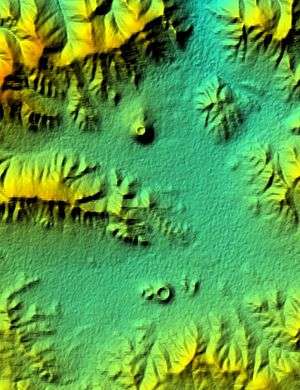Khanuy-Gol
Coordinates: 48°40′N 102°45′E / 48.67°N 102.75°E[1]

Khanuy-Gol (also known as Bulgan Volcanic Field, Chanuj Gol Hanui Gol or Hanuy Gol) is a volcanic field in Mongolia.[1] Khanuy-Gol is located in the northern Hangai range,[2] north of the settlement of Bulgan.[3]

It covers a surface area of 3,500 square kilometres (1,400 sq mi) 150 kilometres (93 mi) southwest of Ulanbator. Among the 10 cones with heights of 30–190 metres (98–623 ft) that make up the field are Baga Togo Uul/Bogo-Togo-Ula (meaning "Little Togo Mountain",[4] 28 metres (92 ft) high,[3] 48°55.79′N 102°46.22′E / 48.92983°N 102.77033°E[2] to 48°55.34′N 102°45.75′E / 48.92233°N 102.76250°E[2]), Ikh Togo Uul/Ikha-Togo-Ula (meaning "Great Togo mountain",[4] 219 metres (719 ft) high,[3] 48°59.53′N 102°44.48′E / 48.99217°N 102.74133°E[2]), Togo, Urun Dush,[1] and Uran Uul. This cone is the highest of the field,[5] with a height of 280 metres (920 ft).[6] Baga Togo Uul has one maar-like vent among its three vents, these vents are named Javalach, Togo and Tulga. Both Togo cones have a vegetation cover.[4][5]
Volcanic activity began 12.5 ± 1.0 mya,[3] with trachybasalts erupting along the Hanui river. Later two unnamed cones less than 20 kilometres (12 mi) west of the river formed Pleistocene lava flows, one of which is 10–12 metres (33–39 ft) thick.[2] The last eruption is not dated, may be in the Holocene though,[1] judging by Uran Uul's steep sided appearance. The Baga Togo Uul cones are certainly older than 3-4 ka and probably Pleistocene.[5] The field is part of the Hangai volcanic region, which is in turn part of the Baikal rift zone. The Hangai region has been subject to tectonic uplift and high heat flow anomalies and hot springs are found.[2]
The rocks erupted by the cones are olivine basalt with inclusions of ilmenite and xenoliths of peridotite in the case of the Togo cones.[1] Some presumably Pleistocene lava flows are basaltic trachyandesites.[2] The Selenga belt of Permian-Triassic age forms the basement of the field.[5]
References
- 1 2 3 4 5 "Khanuy Gol". Global Volcanism Program. Smithsonian Institution.
- 1 2 3 4 5 6 7 Barry, Tiffany L.; Kent, Ray W. (1998). "Cenozoic magmatism in Mongolia and the origin of central and east Asian basalts". 27: 347–364. doi:10.1029/GD027p0347. ISSN 0277-6669.
- 1 2 3 4 Whitford-Stark, J. L. (1987). "A survey of Cenozoic volcanism on mainland Asia". 213: 21. doi:10.1130/SPE213-p1. ISSN 0072-1077.
- 1 2 3 BARRY, T. L. (1 January 2003). "Petrogenesis of Cenozoic Basalts from Mongolia: Evidence for the Role of Asthenospheric versus Metasomatized Lithospheric Mantle Sources". Journal of Petrology. 44 (1): 55–91. doi:10.1093/petrology/44.1.55.
- 1 2 3 4 Harris, Nigel; Hunt, Alison; Parkinson, Ian; Tindle, Andrew; Yondon, Magisuren; Hammond, Samantha (1 December 2009). "Tectonic implications of garnet-bearing mantle xenoliths exhumed by Quaternary magmatism in the Hangay dome, central Mongolia". Contributions to Mineralogy and Petrology. 160 (1): 67–81. doi:10.1007/s00410-009-0466-6.
- ↑ Hunt, A. C.; Parkinson, I. J.; Harris, N. B. W.; Barry, T. L.; Rogers, N. W.; Yondon, M. (2 July 2012). "Cenozoic Volcanism on the Hangai Dome, Central Mongolia: Geochemical Evidence for Changing Melt Sources and Implications for Mechanisms of Melting". Journal of Petrology. 53 (9): 1913–1942. doi:10.1093/petrology/egs038.